Hi Scott! You are correct, good catch. It's been updated.



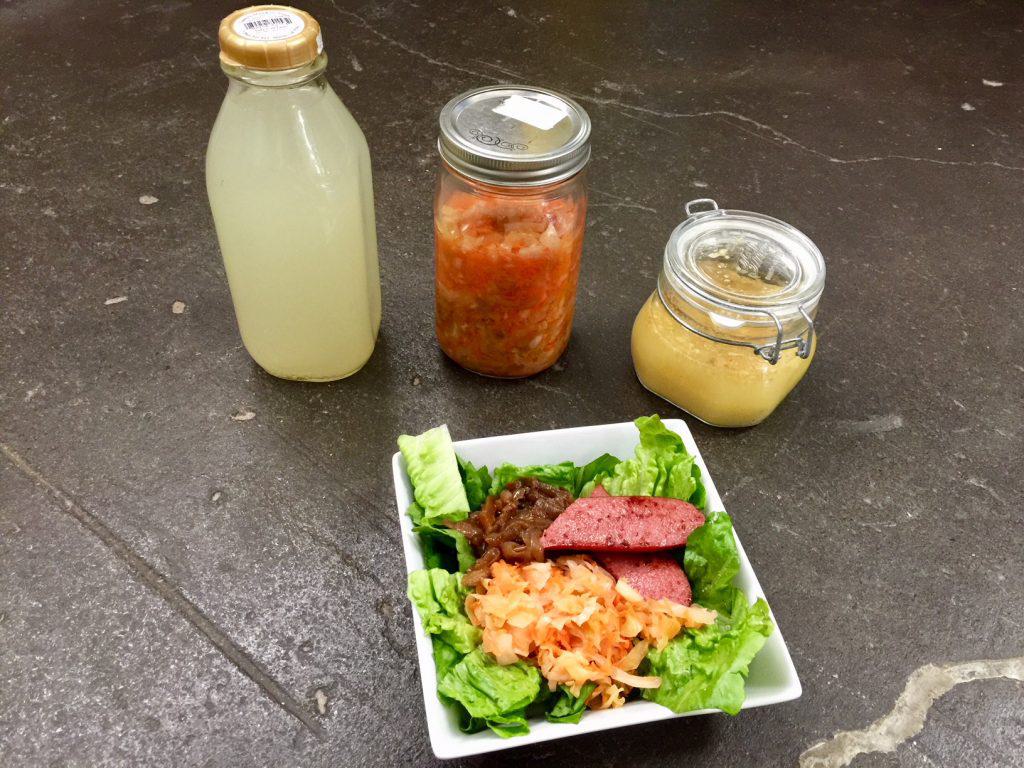 The fruits of my labor: lemonade, sauerkraut and ginger bug. And my yummy sausage, caramelized onion and sauerkraut salad, which I ate for lunch after taking this photo (with a glass of ginger-carbonated lemonade).[/caption]
I had idly thought about making sauerkraut in the past, but I was driven to action when I ate at a local gastropub last summer: a simple salad topped with grilled sausage, caramelized onions and their house-made sauerkraut. It was the sauerkraut that sold me:tangy, complex, slightly sweet, beautifully colored, substantial in texture, it was a far cry from the finely shredded, vinegary white sauerkraut I'd eaten from the store. I closed my eyes and pictured recreating the dish at home, and remembered I had read about fermentation and making sauerkraut on one of my favorite blogs, TheZero-Waste Chef (whose recipes and information I've used here to create this post).I got to work later that week, and--success! It was so easy, and so delicious, I then drafted my son into making a ginger bug (fermented fresh ginger, sugar and water) so we could make naturally carbonated lemonade!
The fruits of my labor: lemonade, sauerkraut and ginger bug. And my yummy sausage, caramelized onion and sauerkraut salad, which I ate for lunch after taking this photo (with a glass of ginger-carbonated lemonade).[/caption]
I had idly thought about making sauerkraut in the past, but I was driven to action when I ate at a local gastropub last summer: a simple salad topped with grilled sausage, caramelized onions and their house-made sauerkraut. It was the sauerkraut that sold me:tangy, complex, slightly sweet, beautifully colored, substantial in texture, it was a far cry from the finely shredded, vinegary white sauerkraut I'd eaten from the store. I closed my eyes and pictured recreating the dish at home, and remembered I had read about fermentation and making sauerkraut on one of my favorite blogs, TheZero-Waste Chef (whose recipes and information I've used here to create this post).I got to work later that week, and--success! It was so easy, and so delicious, I then drafted my son into making a ginger bug (fermented fresh ginger, sugar and water) so we could make naturally carbonated lemonade!
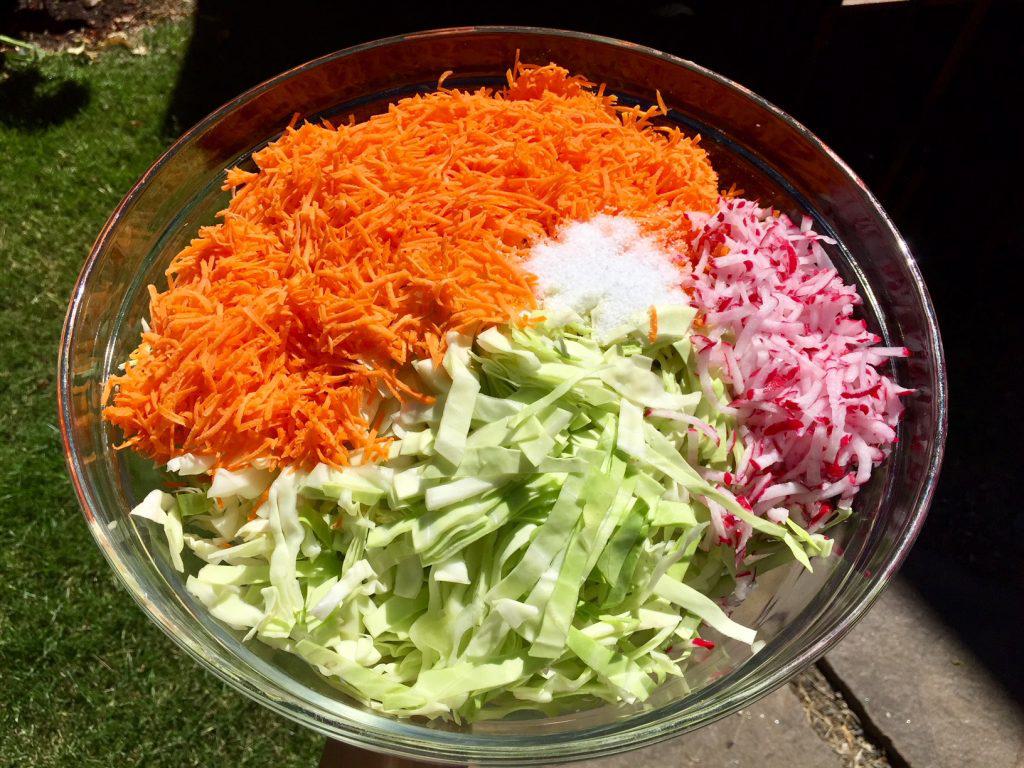 Cabbage, carrot, radishes and salt: just add time and you have sauerkraut![/caption]
Beyond preservation, fermentation can also make food more nutritious. The fermentation process partially digests the food for us, enhancing the availability of certain nutrients like vitamins B and C and reducing anti-nutrients that can inhibit their absorption. True fact: pirates brought sauerkraut on long voyages to protect against scurvy!
Many also believe that the beneficial microorganisms in fermented food will produce a probiotic effect, feeding the "good" bacteria in the gut and generally supporting a healthy immune system. While this has not been proven by modern science, many people have reported anecdotally that they get sick less frequently when they eat fermented foods on a regular basis. Take that with a grain of salt--or a shot of fermented pickle brine, if you prefer!
But finally: fermented foods just taste good! Yes, there may be a bit of an adjustment period for modern palates that have forgotten these intense flavors, but imagine if you only had cabbage, potatoes, cornmeal, and a bit of salt pork to eat. The tangy flavor of sauerkraut, pickles or kimchi provided a rainbow of sensory pleasure to those without access to the new or exotic.
[caption id="attachment_1169455" align="aligncenter" width="750"]
Cabbage, carrot, radishes and salt: just add time and you have sauerkraut![/caption]
Beyond preservation, fermentation can also make food more nutritious. The fermentation process partially digests the food for us, enhancing the availability of certain nutrients like vitamins B and C and reducing anti-nutrients that can inhibit their absorption. True fact: pirates brought sauerkraut on long voyages to protect against scurvy!
Many also believe that the beneficial microorganisms in fermented food will produce a probiotic effect, feeding the "good" bacteria in the gut and generally supporting a healthy immune system. While this has not been proven by modern science, many people have reported anecdotally that they get sick less frequently when they eat fermented foods on a regular basis. Take that with a grain of salt--or a shot of fermented pickle brine, if you prefer!
But finally: fermented foods just taste good! Yes, there may be a bit of an adjustment period for modern palates that have forgotten these intense flavors, but imagine if you only had cabbage, potatoes, cornmeal, and a bit of salt pork to eat. The tangy flavor of sauerkraut, pickles or kimchi provided a rainbow of sensory pleasure to those without access to the new or exotic.
[caption id="attachment_1169455" align="aligncenter" width="750"]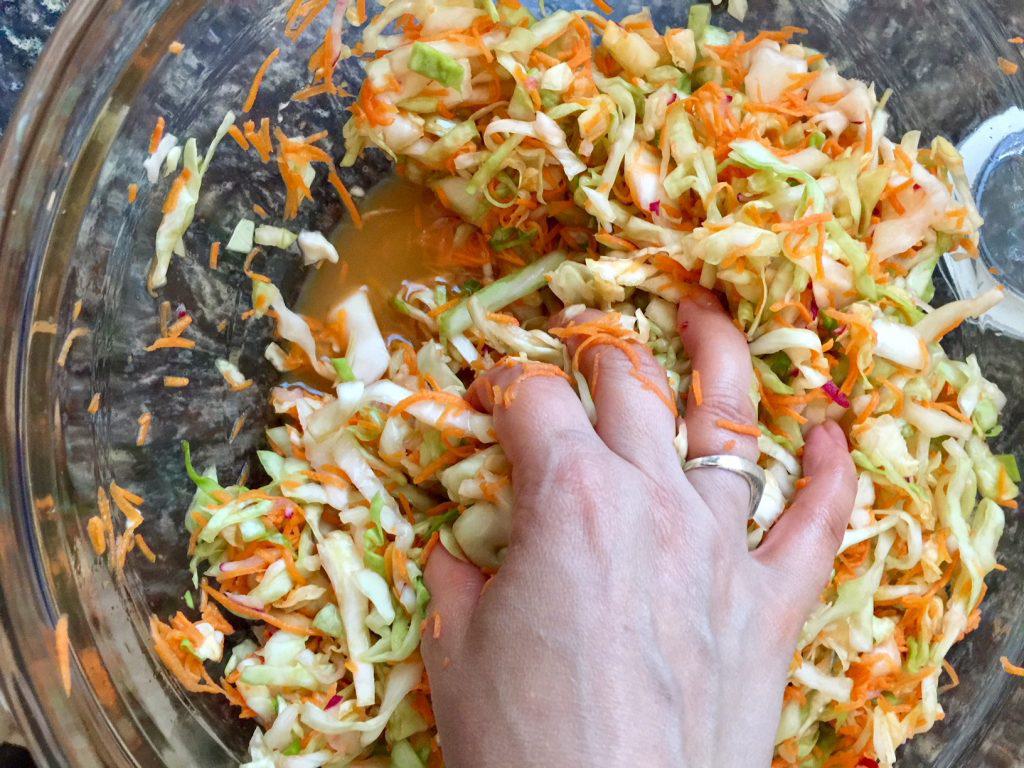 Squeezing the vegetables to release the liquid.[/caption]
Squeezing the vegetables to release the liquid.[/caption]
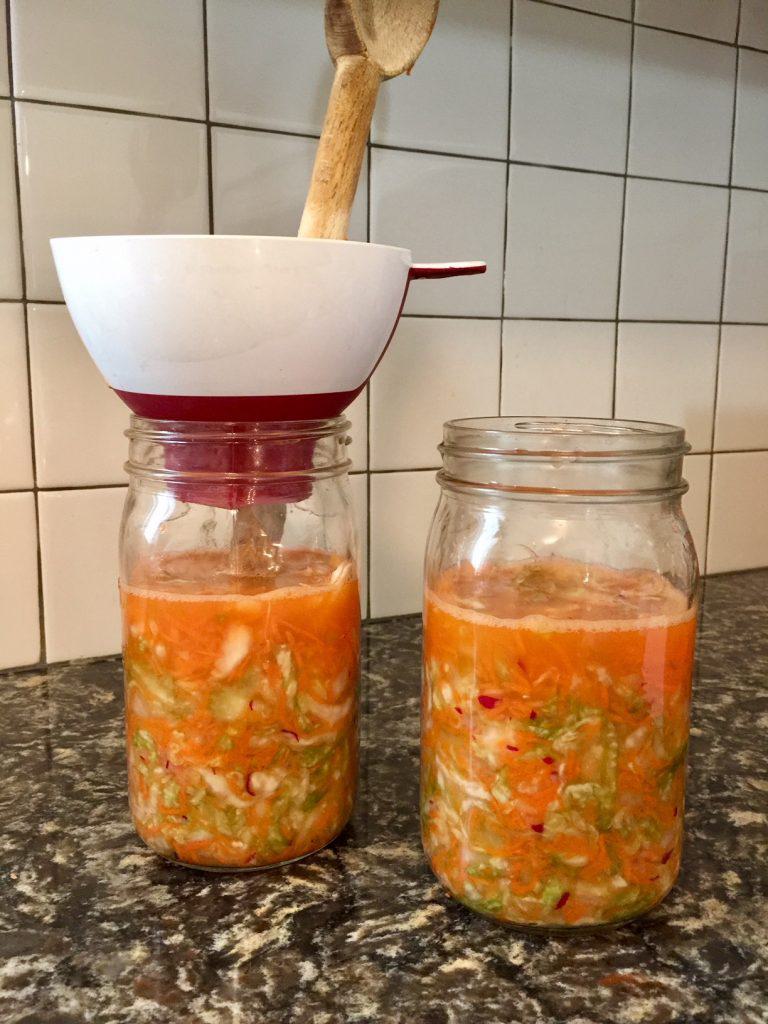 Packing the soon-to-be sauerkraut into jars.[/caption]
This recipe is used with permission from The Zero-Waste Chef. I made a few alterations, so be sure to check out the original! You can use your own unique mixture of vegetables--use this as a loose guide. #ProTip: This sauerkraut is the perfect way to brighten up a grain bowl--be sure to sign up for our free Build a Better Grain Bowl e-book while you're at it!
1 large head Cabbage, quartered and cored (I chose green)
5 Carrots, shredded (I used the smaller of the two grating discs that came with my food processor)
5 Radishes (I used the larger shredding disc)
1 Tablespoon Kosher Salt
Thinly slice the cabbage and add to a large glass bowl, along with the carrots, radishes and salt. Mix them together with clean hands and then squeeze handfuls of the mixture to help break down the cellular walls and release the water. Let rest a few hours, weighing down the vegetables with a small dish if desired to draw out more water (I did not).
Next, pack the soon-to-be sauerkraut into clean glass jars (I used the handle of a clean wooden spoon for the pictures, but usually I use my clean hands). Press down firmly--I was able to fit everything in two 1-quart jars, with space to spare. You want to submerge the vegetables under the liquid to prevent them from spoiling. If you don't have enough liquid, add a little water. If you need to add a lot of liquid, make a brine with some salt and water and pour over to cover.
[caption id="attachment_1169459" align="aligncenter" width="750"]
Packing the soon-to-be sauerkraut into jars.[/caption]
This recipe is used with permission from The Zero-Waste Chef. I made a few alterations, so be sure to check out the original! You can use your own unique mixture of vegetables--use this as a loose guide. #ProTip: This sauerkraut is the perfect way to brighten up a grain bowl--be sure to sign up for our free Build a Better Grain Bowl e-book while you're at it!
1 large head Cabbage, quartered and cored (I chose green)
5 Carrots, shredded (I used the smaller of the two grating discs that came with my food processor)
5 Radishes (I used the larger shredding disc)
1 Tablespoon Kosher Salt
Thinly slice the cabbage and add to a large glass bowl, along with the carrots, radishes and salt. Mix them together with clean hands and then squeeze handfuls of the mixture to help break down the cellular walls and release the water. Let rest a few hours, weighing down the vegetables with a small dish if desired to draw out more water (I did not).
Next, pack the soon-to-be sauerkraut into clean glass jars (I used the handle of a clean wooden spoon for the pictures, but usually I use my clean hands). Press down firmly--I was able to fit everything in two 1-quart jars, with space to spare. You want to submerge the vegetables under the liquid to prevent them from spoiling. If you don't have enough liquid, add a little water. If you need to add a lot of liquid, make a brine with some salt and water and pour over to cover.
[caption id="attachment_1169459" align="aligncenter" width="750"]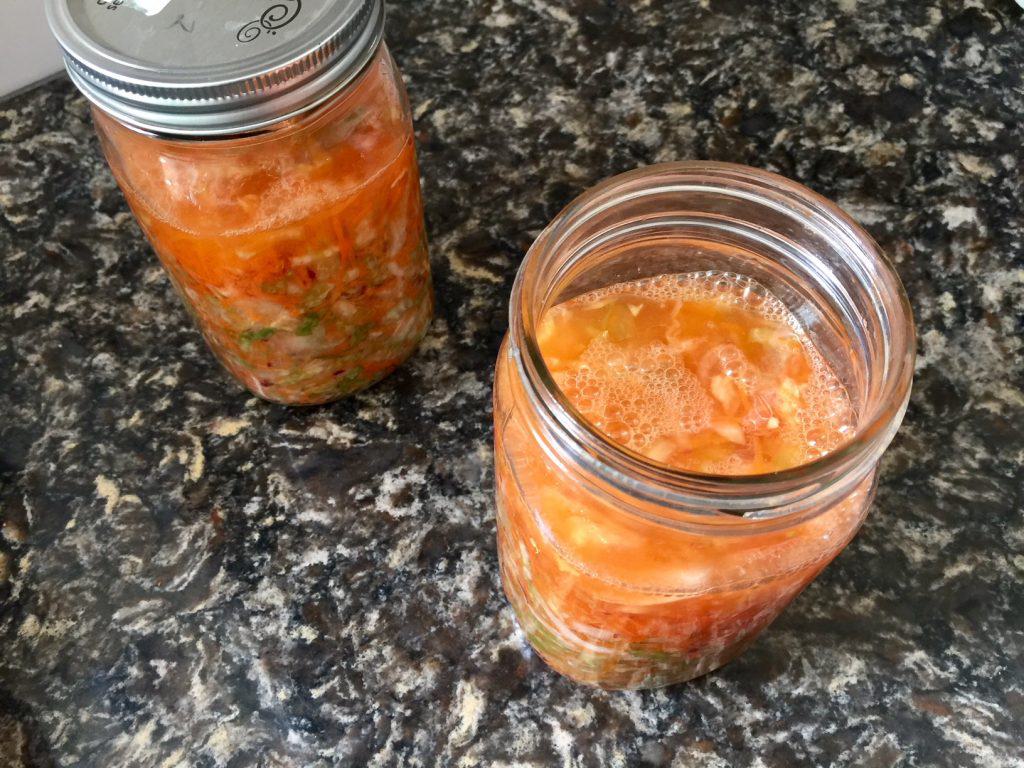 It's alive! Fermentation begins and bubbles rise to the top.[/caption]
Screw on the lids, place them on your kitchen counter or in a cupboard, and wait! You can buy fancy fermentation vessels, but I've had great results from my Mason jars--just remember to open the lids and "burp" them once a day so the gases don't build up and explode. This is usually only necessary the first few days.
My kitchen was extremely warm (hello heat wave), so my sauerkraut started fermenting the very next day! I opened the jar to check and it was bubbling away. Eventually the liquid will turn cloudy and the vegetables will change color a bit--these are signs of successful fermentation! I checked my jars daily, pushing down the vegetables as needed (you can also use a small dish or a cabbage leaf to keep everything submerged). Taste daily or weekly until it "sours" to your taste. Many people let it ferment for months, but I usually start eating it after a week or so.
Once it's ready to eat, store your sauerkraut in the refrigerator. This will largely stop the fermentation process (no more burping!). If the top layer of vegetables ever looks spoiled or--very rare--develops black, white or green mold, scrape it off. The sauerkraut below should be safe to eat. However, if mold of any other color develops, throw the whole thing out.
[caption id="attachment_1169460" align="aligncenter" width="750"]
It's alive! Fermentation begins and bubbles rise to the top.[/caption]
Screw on the lids, place them on your kitchen counter or in a cupboard, and wait! You can buy fancy fermentation vessels, but I've had great results from my Mason jars--just remember to open the lids and "burp" them once a day so the gases don't build up and explode. This is usually only necessary the first few days.
My kitchen was extremely warm (hello heat wave), so my sauerkraut started fermenting the very next day! I opened the jar to check and it was bubbling away. Eventually the liquid will turn cloudy and the vegetables will change color a bit--these are signs of successful fermentation! I checked my jars daily, pushing down the vegetables as needed (you can also use a small dish or a cabbage leaf to keep everything submerged). Taste daily or weekly until it "sours" to your taste. Many people let it ferment for months, but I usually start eating it after a week or so.
Once it's ready to eat, store your sauerkraut in the refrigerator. This will largely stop the fermentation process (no more burping!). If the top layer of vegetables ever looks spoiled or--very rare--develops black, white or green mold, scrape it off. The sauerkraut below should be safe to eat. However, if mold of any other color develops, throw the whole thing out.
[caption id="attachment_1169460" align="aligncenter" width="750"]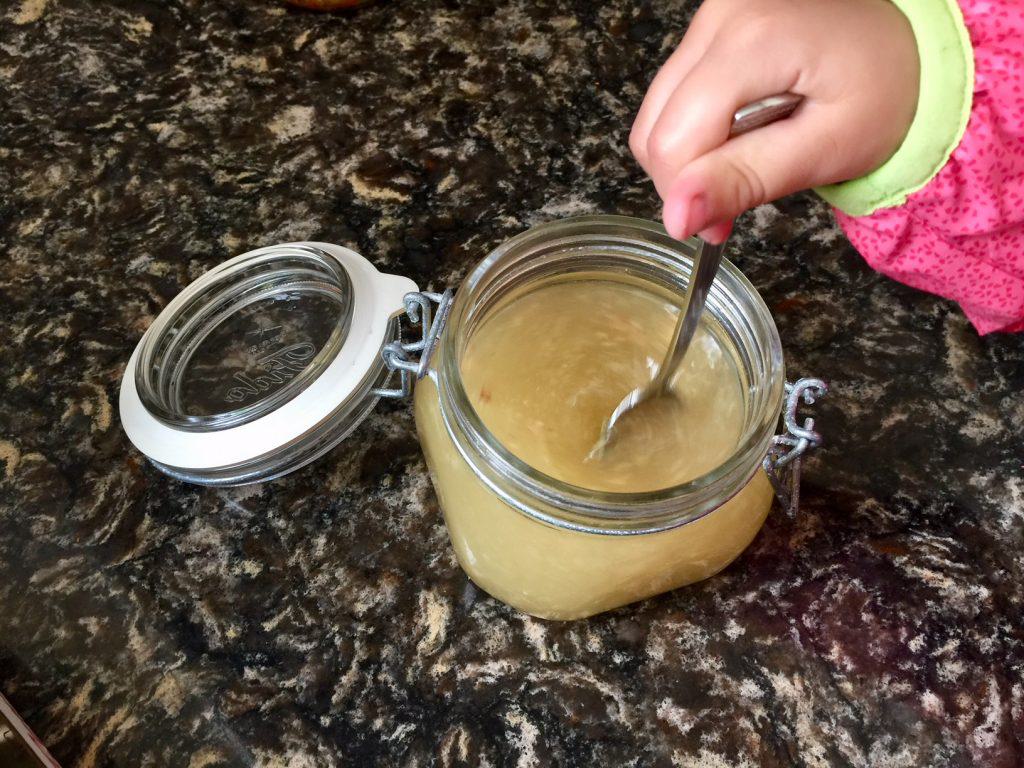 My three year old feeds and stirs the ginger bug. Does this count as a pet?[/caption]
My three year old feeds and stirs the ginger bug. Does this count as a pet?[/caption]
 My ginger bug, nicely stirred and ready for covering.[/caption]
Your ginger bug should be ready to use in about five days. You'll see bubbling and smell yeast. The ginger will float to the top and there will be a whitish substance at the bottom--that's the good stuff! To use, stir vigorously and pour some of it out through a fine mesh strainer. You can store your mature ginger bug in the refrigerator, but you'll still want to feed it once a week: take it out, let it return to room temperature, then feed it 1 tablespoon each of sugar and fresh ginger. Let sit for a few hours, then return to the fridge.
I loveThe Zero Waste Chef's recipe for naturally carbonated lemonade and make it regularly! Because the ginger bug feeds on the sugar, it's a little less sweet and has a wonderfully zingy ginger flavor. Here's how to make it:
4 cups Water
1/2 cup Sugar, or to taste
1/2 cup Lemon Juice, with or without pulp
1/4 cup strained Ginger Bug liquid
Bring 1 cup of water to a boil and mix with the sugar until dissolved. Then add 3 cups cold water and stir (do not add your ginger bug to hot water, it will kill the microbes and won't ferment). Add the lemon juice and ginger bug liquid and stir to combine.
[caption id="attachment_1169461" align="aligncenter" width="750"]
My ginger bug, nicely stirred and ready for covering.[/caption]
Your ginger bug should be ready to use in about five days. You'll see bubbling and smell yeast. The ginger will float to the top and there will be a whitish substance at the bottom--that's the good stuff! To use, stir vigorously and pour some of it out through a fine mesh strainer. You can store your mature ginger bug in the refrigerator, but you'll still want to feed it once a week: take it out, let it return to room temperature, then feed it 1 tablespoon each of sugar and fresh ginger. Let sit for a few hours, then return to the fridge.
I loveThe Zero Waste Chef's recipe for naturally carbonated lemonade and make it regularly! Because the ginger bug feeds on the sugar, it's a little less sweet and has a wonderfully zingy ginger flavor. Here's how to make it:
4 cups Water
1/2 cup Sugar, or to taste
1/2 cup Lemon Juice, with or without pulp
1/4 cup strained Ginger Bug liquid
Bring 1 cup of water to a boil and mix with the sugar until dissolved. Then add 3 cups cold water and stir (do not add your ginger bug to hot water, it will kill the microbes and won't ferment). Add the lemon juice and ginger bug liquid and stir to combine.
[caption id="attachment_1169461" align="aligncenter" width="750"]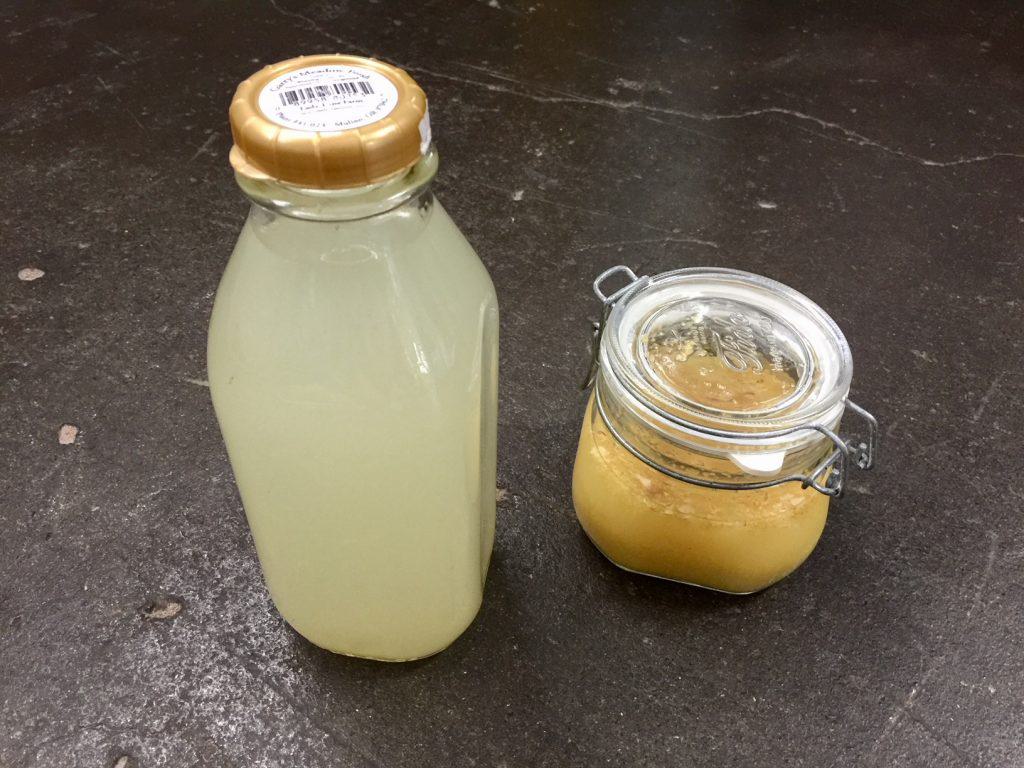 My ginger bug and delicious, carbonated lemonade![/caption]
Use a funnel to pour your lemonade into glass bottles (I used clean milk bottles, flip top ones will work too, or even plastic bottles). Set them aside for two or three days (I tend to place them in a cupboard just in case), checking them daily. Remember to remove the lids to "burp" them so they don't explode! Place in the refrigerator when it's carbonated to your liking.
My lemonade is generally well carbonated after three or four days. What I love about this is unlike conventional soda, soda made with a ginger bug doesn't lose carbonation after you open it--if anything, it becomes more bubbly, in my experience, after a few days in the refrigerator. Thank you ginger bug! Questions? Read Fermentation FAQs here!
I had so much fun making these for this blog post--in fact, I think I'm ready to tackle scrap vinegar! Do you have experience with fermentation? What's your favorite thing to make? Post your comments below!
My ginger bug and delicious, carbonated lemonade![/caption]
Use a funnel to pour your lemonade into glass bottles (I used clean milk bottles, flip top ones will work too, or even plastic bottles). Set them aside for two or three days (I tend to place them in a cupboard just in case), checking them daily. Remember to remove the lids to "burp" them so they don't explode! Place in the refrigerator when it's carbonated to your liking.
My lemonade is generally well carbonated after three or four days. What I love about this is unlike conventional soda, soda made with a ginger bug doesn't lose carbonation after you open it--if anything, it becomes more bubbly, in my experience, after a few days in the refrigerator. Thank you ginger bug! Questions? Read Fermentation FAQs here!
I had so much fun making these for this blog post--in fact, I think I'm ready to tackle scrap vinegar! Do you have experience with fermentation? What's your favorite thing to make? Post your comments below!
Where you say "feed it 1 tablespoon each of water and fresh ginger" I believe you meant to write ..."of sugar and fresh ginger." Please forgive me, please, if I am mistaken.